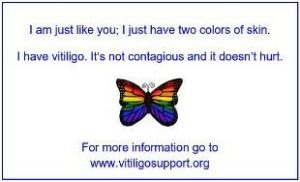In This Issue
Directors Message:
Support VSI
VSI Awarded:
Guidestar Gold Seal of Transparency
Embracing Diversity:
We All Have a Role
Insurance Assistance for Vitiligo Treatments
What’s on Your Mind?
Could Getting a Tattoo Make My Vitiligo Spread?
Medical News Updates
First Results in From RECELL Clinical Trial!
Opzelura Vitiligo Treatment Approved!
Research & Clinical Trials
New! Survey to Assess Psychological Impact of Vitiligo Stigma
Participate in Research About Impact of COVID-19 on Vitiligo
Paid Vitiligo Study in NYC
Bibliography and Sources
Advocacy is any action that speaks in favor of,
recommends, argues for a cause, supports or
defends, or pleads on behalf of others.
Source: National Council of Nonprofits
When I was first diagnosed with vitiligo, my doctor told me there were no treatments, but vitiligo wouldn’t hurt me, so the best thing to do would be to go home and try to forget about it.
There were no vitiligo patient advocacy groups at that time, I had to research on my own. In time I found that there were treatments that worked, but the doctors I saw refused to prescribe them because they were off-label. It was emotionally devastating watching my pigment disappear, knowing there were treatments, but out of my reach ….
The emotional pain I experienced all those years ago,
paved the road of my journey to become a patient advocate.
I was determined to be the voice for those
who were unable to speak for themselves.
How dare a vitiligo patient be told there are no treatments! Or worse, how dare a physician refuse to prescribe a treatment proven to work, simply because it was off-label!
Your Advocacy Investment is Paying Off!
Not only do we now have the first ever FDA-approved treatment for the repigmentation of vitiligo, but there seems to be a veritable footrace in the pharmaceutical industry to be next in line.
In a refreshing break from the drug marketing clamor, another strong area of interest for these pharmaceutical companies is learning and caring about what the patients want from treatments.
Historically, drug treatment input came solely from researchers and clinicians. As the prescribers, the clinicians had the most contact with the patients. However, slowly but surely, thanks in large part to patient advocates like VSI, the voice of the patient now permeates this conversation.
Case in Point
How many of you experienced itching when your vitiligo was active? I, for one, can tell you that itch IS a very real symptom for a LOT of vitiligo patients. Yet, I had a very prominent vitiligo researcher tell me “itch” was likely not associated with vitiligo. Itch was not listed in enough physician records to be considered a legitimate symptom.
Why would it be in the records when it had been summarily dismissed as symptom? The fact is that for most who DO experience this intense itching, it occurs at the very onset of disease activity before noticeable loss of pigment is visually detected. By the time pigment loss is apparent, the itching has long-ago stopped. If no one is asking the question, very few put 2 + 2 together.
In 2012 VSI collaborated with French researchers who noted itch as a lesser known symptom of vitiligo. We polled our members at that time. We received nearly 700 responses with 92% reporting that YES, they had experienced itch with their vitiligo.
Itch is now scientifically recognized as a symptom
affecting up to 1/3 of those with active vitiligo.
THIS is Why Patient Advocacy is So Important
As a 501(c)(3) nonprofit organization,
VSI is dependent on public funding to operate.
If it’s Important to You
That VSI Continues its Efforts on Your Behalf to:
Advocate and Increase Vitiligo Awareness
Make Sure the Voice of the Vitiligo Patient
is Heard and Understood
Provide Trusted, Current Resources like these Newsletters
Please Consider a Donation to Sustain this Vital Work.
Together We Can Make a Difference!
Each year as fall approaches, VSI begins receiving requests for information and support from parents of children with vitiligo. Whether first-time students or those just moving up a grade level, there are steps you can take to help ensure a positive start to a new school year.
Whether you’re a student, parent, teacher, neighbor, or co-worker, everyday interactions are opportunities to help others understand that we all have differences. Diversity education is applicable from pre-school to the workplace and beyond to the broader community life.
VSI would like to thank Lori Mitchell, author and graphic artist, for her outstanding work in diversity education. Lori has written and illustrated several children’s books – the most well-known being Different Just Like Me that she wrote to help children and adults alike learn to appreciate and respect diversity.

A great deal of the following material was based on an article entitled “Making a Difference at The Start, and All Through the School Year,” that Lori wrote when her daughter April was entering kindergarten.
Making a Difference at School
Many parents think that teachers will handle socially integrating a child with differences or special needs into the classroom. However, with privacy laws and regulations such as the Family Educational Rights and Privacy Act Regulations (FERPA) and the Health Insurance Portability and Accountability Act (HIPAA), most school districts prohibit teachers from discussing any child’s special circumstances without first receiving permission from the parents. So days, even weeks, can go by without the child getting the help he/she needs.
Look for Ways to Start the Conversation
 Experience has shown that the earlier the child is properly introduced to the class, the sooner he/she is understood and accepted. If it’s left even for a day, teasing and misunderstandings may prevail.
Experience has shown that the earlier the child is properly introduced to the class, the sooner he/she is understood and accepted. If it’s left even for a day, teasing and misunderstandings may prevail.
There are as many different ways to introduce a child with a special situation into the class as there are students, but the process begins with a conversation between the teacher, the parents, and the child.
On the first day of school, we dressed April in colorful tights and a long sleeve shirt to cover the most noticeable parts of her vitiligo. We typed up a letter as if April had written it, and explained what vitiligo was and wasn’t. There was a picture of April and her signature. It not only talked about April’s skin, but also about her pet cat and a few of April’s favorite things to do, as well as her favorite foods.
sleeve shirt to cover the most noticeable parts of her vitiligo. We typed up a letter as if April had written it, and explained what vitiligo was and wasn’t. There was a picture of April and her signature. It not only talked about April’s skin, but also about her pet cat and a few of April’s favorite things to do, as well as her favorite foods.
This way it wasn’t just about her condition,
but also introduced April as a person and friend.
We sent the letter home for the parents to read to their children. The next day April wore her usual shorts and t-shirt. There were a few friendly questions, but from then on she was just another kid in class. Click here to see April’s letter.
Little Things Can Make a Big Difference
 Once I had a chance to talk with her teacher, I realized that she wanted to be involved and welcomed the opportunity to help in any way she could. She did a very simple thing that made a big difference. She put her arm around April. That simple act showed the kids that she liked April, and also that her vitiligo was not contagious.
Once I had a chance to talk with her teacher, I realized that she wanted to be involved and welcomed the opportunity to help in any way she could. She did a very simple thing that made a big difference. She put her arm around April. That simple act showed the kids that she liked April, and also that her vitiligo was not contagious.
Importance of Communication
In fourth grade, I didn’t think I needed to talk to April’s teacher. However, a few weeks into the school year, April came home and told me two boys had been calling her and her friend bad names. I realized I needed to make sure that her teacher knew I wanted to be informed of anything like this.
It’s important to keep communication open with your child.
Ask them how their day went.
Watch for any signs or changes in their personality.
April would usually tell me if anyone said anything about her vitiligo. I would try to just listen and let her figure out what she wanted to do about it. I think that helped her feel like she had more control. I wasn’t going to be there every time someone said something to her so she would have to know, and feel confident, that she could deal with it on her own. If she asked for ideas, I would suggest something, but I would usually let her go through a list of her own ideas first.
Practice at Home:
Role-play
I found that role-playing with April helped prepare her learn how to respond in different situations.  Sometimes we would use stuffed animals as the bully. Other times I would be the bully and call April names, like a tomato. She would laugh. I asked if she thought she was a tomato and she would say “of course not.” The point was that anyone can say anything, but that doesn’t make it true.
Sometimes we would use stuffed animals as the bully. Other times I would be the bully and call April names, like a tomato. She would laugh. I asked if she thought she was a tomato and she would say “of course not.” The point was that anyone can say anything, but that doesn’t make it true.
Only if you accept it and decide they are right can it hurt you.
We talked about how much her family and friends loved her just the way she was. We also talked about bullies and some of the reasons they might be teasing her. It could be that they were scared of catching vitiligo. It could be that they were being teased at home or they didn’t feel good about themselves. We emphasized that the behavior of bullies very rarely has anything to do with the people they are teasing.
The point of role-play is not to come up with
the one and only perfect reply to any teasing….
There will be different situations when your child will have to think on his/her feet. The point is to have the discussion with your child before the bully does. The bully will zero in on any insecurities the child might be feeling. If you can role-play and have an open, honest discussion, the shame is diminished if not totally dissolved.
Let Your Child be Your Guide
Some children are more outgoing than others. Talk with your child and provide a few ideas on what to say to the other children. Nothing formal is needed, just a few simple and honest responses, such as:
I have vitiligo.
It’s not contagious.
It’s just two colors of skin,
like some people have freckles.
Other Ways to Help Your Child Explain:
April came up with the idea of handing out cards explaining her vitiligo. On each card she printed, “I’m just like you; I just have two colors of skin. I’m not contagious and it doesn’t hurt.” April decorated them with stickers on the back and included VSI’s website address.

The cards were a big hit, and I think made her feel like she had a little more control over the situation. As April got older she became more comfortable answering questions about vitiligo, but she still kept the cards, just in case.
Classroom Diversity Education
 As a parent, if you have the time, you may want to offer to lead a discussion on diversity in your child’s classroom. Even if you only have 15 or 20 minutes, it’s worth the time.
As a parent, if you have the time, you may want to offer to lead a discussion on diversity in your child’s classroom. Even if you only have 15 or 20 minutes, it’s worth the time.
Discussions on diversity help all of the students. To prevent any one child from feeling singled out, you can talk to the class about differences in a general way, or have a day where each student gets a few minutes to tell something unique about themselves.
Frequently, the students in April’s class shared personal stories about their family members that had some kind of difference. For many students, this was their first opportunity to share this information. Every child in class had felt different at one time in their life, and it’s usually a great relief for them to know they weren’t the only one.
Helping children understand that they are each different in some ways and alike in others helps them become more accepting of differences as they go through life.
Same and Different Classroom Exercises
Ask the Children to Raise Their Hand:
If they have:
blonde hair, brown hair, a brother, a sister, or a pet
OR
If they like to:
eat pizza, eat broccoli, go to the movies, or go swimming
Bring in pictures of two similar objects that have differences, like fish.
|
Have the children list ways the fish are: The Same:
|
|
Ask students to line up, or if class size is large,
first break into two groups, then line up.
Begin by instructing the children to go down the row each saying one thing about themselves that makes them different from the person on their right. When they get to the end, start over and have them say one thing that makes them the same as the person on their right.
Remind them before they start that you want to come up with as many different ideas as possible, trying not to have any repeats.
Make sure that they say “I,” not “YOU,”
As in:
“I” am different
because
I have blue eyes and yours are brown.”

Never Judge a Book by Its Cover
Take a plain brown bag, crumple it up and fill it with lollipops, then tie it with some old string. Now fill a beautiful gift bag with toilet paper and tie it with ribbons and bows. Ask the students to pick a bag. Once the bags are opened, ask them how they think this relates to people.
The children will soon begin to understand that each one of them are different in some ways and alike in others. Within a week or so, most will forget about differences, and get on with playing and learning.
We hope that this article has helped you consider not only the ways that you might evoke positive change in the preconceived notions of others, but that you also keep your own mind open to personal changes you might need to make to improve in your role as a vitiligo ambassador for diversity awareness and acceptance.

Have You Ever Been Denied Insurance
Coverage For Your Vitiligo Treatments?
According to the Derma Care Access Network (DCAN):
“If you have been denied access to treatment,
you have the right to file a complaint.”
DCAN developed a step-by-step guide to help patients resolve insurance disputes.
The DCAN guide outlines the actions and procedures you can take,
and provides direct links to “File a Complaint” in each state.
Click Here to See the DCAN Guide to
Filing an Insurance Complaint for Skin Conditions.
Click Here for the Direct Link to File an Online Complaint in Your State.

Q. Can getting a tattoo over a vitiligo spot cause it to spread?
I’ve been thinking about getting a tattoo to try to cover or camouflage an area of vitiligo on my arm, but I’m worried about possible side-effects.
Is there any research on the topic of vitiligo and tattooing?
A. Actual research on the topic of vitiligo and tattooing has been somewhat scarce, so we’ve mostly had to rely on anecdotal accounts from those who have tried the procedure, and/or the dermatologists who have treated them.
However, four dermatologists in New Delhi, India published an article in 2020 about a 24-year old female with no personal or family history of autoimmunity, who developed vitiligo on her forehead 2 years prior. After receiving treatment, she regained some, but not all of the pigment.
Once the vitiligo remained stable for 9 months, she decided to try tattooing to camouflage the remaining depigmented area. Unfortunately, this triggered a reactivation of her vitiligo, leading to an increase in size of the existing lesions and spreading of new areas.
The doctors pointed out the consideration for those with vitiligo getting a tattoo is the association with Koebner’s Phenomenon, which can cause pigment loss at the site of skin trauma such as cuts, scratches, burns, or, in this case, tattooing.
VSI previously published a report from Dr. John Harris, a highly esteemed vitiligo researcher and dermatologist discussing his thoughts regarding tattooing vitiligo based on the experiences of some of his patients and also included photographs. Click here to see that article.

September 12, 2022:
AVITA Medical, Manufacturer of the RECELL System, Announced:
“Positive Topline Pivotal Trial Results for
Treatment of Stable Vitiligo Using the RECELL System.”
VSI has been reporting on the RECELL device clinical trials for vitiligo since 2014, including
recruitment announcements in three VSI newsletters in 2021.
The RECELL system uses a small amount of the patient’s own skin to create an application of Spray-On Skin™ Cells, which are then applied to the prepared depigmented area, and covered with a dressing.
The study was designed such that each participant randomly received RECELL treatment in one depigmented area, and the study control in another depigmented area. Narrowband ultraviolet-B phototherapy (NB-UVB) was used as the study control treatment.
The results showed that 56% of RECELL treatments (versus 12% of control treatments) resulted in repigmentation of more than 50% of the treated area, while 36% of RECELL treatments (versus 0% of control treatments) resulted in repigmentation of at least 80% of the treated area.
According to AVITA Medical’s Press Release:
“Repigmentation is challenging to manage and burdensome for patients with vitiligo,” said
Iltefat Hamzavi, MD, of Henry Ford Hospital (Detroit, MI), lead investigator of the trial. “These
are encouraging results that underscore the potential for RECELL to address repigmentation in patients with stable vitiligo in a rapid and sustained fashion which is distinct from existing therapies.”
In February 2022, the FDA reviewed and approved the Premarket Approval for the RECELL Device. AVITA Medical is planning for submission for approval to FDA by the end of 2022.
VSI will keep you posted on updates!
For Additional Information,
See VSI’s Fall 2021 Newsletter

July 18, 2022:
Opzelura (ruxolitinib cream) Receives Full FDA Approval as the
First On-Label Treatment for the repigmentation of vitiligo!
For decades, those seeking vitiligo treatments for repigmentation have had to settle for off-label medications approved for other conditions, such as eczema and psoriasis. This small detail has given many physicians, as well as insurance companies, a built-in excuse not to prescribe, or cover, desperately-needed treatments.
The FDA Approved Incyte’s Ruxolitinib Cream for Adults and Children Ages 12 and Up.
Below, a before and after photo of Berardo Rivas,
a participant in the ruxolitinib clinical trials.
Berardo, who has been living with vitiligo for over 30 years, said growing up being judged for his skin was very traumatizing. Rivas said he jumped for joy the first time he looked in the mirror and saw the pigment coming back around his eyes!
Opzelura Manufacturer Incyte, Sponsors Financial Assistance Options
Through its Program called IncyteCARES.
Click here to learn more about the IncyteCARES assistance options.
![]()
New Opportunity to Have Your Voice Heard!

Along with his colleagues, David Garate, a second-year medical student at the Univ. of Texas Medical Branch John Sealy School of Medicine, is conducting a survey to assess the impact of vitiligo stigma on psychological well-being.
No personal information will be collected in the survey, which will take about 15 minutes. Participation is voluntary, and you may withdraw
at any time.
Requirements:
- You must have vitiligo, or be the parent of a child with vitiligo,
to participate in the survey.
This is your chance to have your voice heard
and help the medical field gain a
better understanding of what it is like to live with vitiligo.
To Participate in this Valuable Research:
Click Here
Does Autoimmune Vitiligo
Protect Against COVID‐19 Disease?
The Netherlands Institute for Pigment Disorders of the Amsterdam
University Medical Centre, is conducting a research to study the influence of vitiligo on COVID-19.
They would like to determine whether having vitiligo might make one more susceptible, or less susceptible to developing COVID-19; how severe the illness is for those with vitiligo that DO develop COVID-19, and what, if any, effect COVID-19 might have on vitiligo disease activity.
They are seeking Participants WITH Vitiligo
As well as
Participants WITHOUT Vitiligo (as Controls).
(If you have a friend or family member without vitiligo who would be
willing to take the control survey, that would help them tremendously!)
The questionnaire takes 10-15 minutes to complete.
ALL data will be confidential and processed anonymously.
———————-
If you DO HAVE Vitiligo: Click here
If you DO NOT HAVE Vitiligo: Click here
Vitiligo Patients Needed
For PAID Research Study at Mt. Sinai
Visits May Occur at one of the Following
Mt. Sinai Medical Office locations:
5 East 98 Street NYC– 5th Floor
234 East 85 Street NYC – 5th Floor
The Mt. Sinai Department of Dermatology Clinical Trials Center is
looking for patients diagnosed with vitiligo to participate in a clinical
research study.
- If you or your child have been diagnosed with vitiligo
you may qualify to participate. - All ages accepted.
- Only one visit required, which will include a blood draw
and tape strips which are used instead of needle biopsy.
For Additional Information
Contact Dermatology Clinical Trials at:
212-241-3288
(reference biopsy study)
Online Shopping Can Benefit VSI!
Shop Amazon and Support VSI
We ALL shop on Amazon – RIGHT?
Now, with one click you can support VSI at the same time!
Simply click the Amazon Smile link https://smile.amazon.com/ and
designate Vitiligo Support International as your charity of choice.
You only have to do it once, there’s no additional cost to you,
and Amazon will donate a percentage of the sales!
Tobi Cares Donation Program
Tobi is an online women’s clothing design label that brings LA style from its design studio
direct to its online clothing store at tobi.com. Go to Tobi Cares and sign up for VSI to receive 1% of your purchase amount.
IGIVE SHOPPING
iGive.com offers access to free shipping deals and exclusive coupons, on top of the great deals you’ll find every day through its network of 1,000+ stores, including Pottery Barn, REI, Staples, Petco, Expedia, Best Buy, QVC and many more. Best of all, up to 26% of your purchase at each store is donated to VSI at no cost to you! Let friends and family know so they can support VSI, too. Click register for iGive to get started today, and download the iGive button to automatically benefit VSI whenever you go to an included store. You can also raise a penny per search through iGive’s search engine, isearchigive.com.
GOODSEARCH SHOPPING AND DINING!
GoodSearch and Goodshop, like iGive, offers coupons, discounts, and donations to VSI through its network of over 5,000 stores. Just click the link above to get the savings started and the donations flowing!
Earn Funding for VSI with eBay
Support VSI with Ebay!
Do you sell items on eBay, or want to hold an online garage sale? If so, consider donating a percentage of your proceeds to VSI through eBay’s Giving Works program! It’s easy – when you list an item through a Giving Works listing, choose to send 10-100% of the final sale price to VSI. Your listing will have a special placement and designation. You’ll receive a proportional fee credit from eBay, and will also receive a tax donation receipt when the donation is deducted from your funds received. It’s a great opportunity to make some money for yourself and for VSI, so clean out those closets and garages and get selling!
To Learn More About VSI’s Giving Works: Click here
Copyright © 2022 Vitiligo Support International Inc. All rights reserved.
Reproduction or republication strictly prohibited without prior written permission.
A Vitiligo Support International, Inc. financial statement is available upon written request from the Virginia Office of Consumer Affairs.
Mail requests to: Virginia Department of Agriculture and Consumer Services, Office of Charitable and Regulatory Programs, P.O. Box 1163, Richmond, Virginia 23218.



 Dear VSI Members, Friends, and Donors,
Dear VSI Members, Friends, and Donors, 





